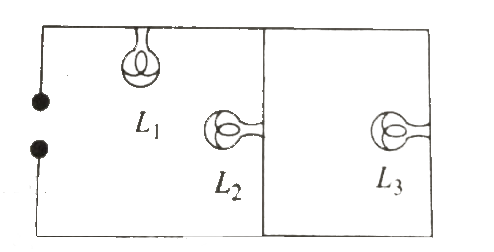Homoleptic octahedral complexes of a metal ion '' with three monodentate ligands and absorb wavelengths in the region of green, blue and red respectively. The increasing order of the ligand strength is :
To determine the increasing order of ligand strength for the given monodentate ligands L1,L2, and L3 that absorb wavelengths in the regions of green, blue, and red respectively, we can follow these steps:
Step 1: Understand the relationship between wavelength and ligand strength
- The absorption of light by a complex ion is related to the crystal field splitting energy (Δo).
- A shorter wavelength corresponds to a higher energy transition, which indicates a stronger ligand (higher Δo).
- Conversely, a longer wavelength corresponds to a lower energy transition, indicating a weaker ligand (lower Δo).
Step 2: Assign the ligands to their respective wavelengths
- From the question:
- L1 absorbs green light.
- L2 absorbs blue light.
- L3 absorbs red light.
Step 3: Determine the energy associated with each color
- The order of increasing wavelength (and thus decreasing energy) is:
- Red > Green > Blue
- Therefore, we can assign the relative strengths based on the absorption:
- L3 (red) has the lowest energy and is the weakest ligand.
- L1 (green) is stronger than L3 but weaker than L2.
- L2 (blue) has the highest energy and is the strongest ligand.
Step 4: Write the increasing order of ligand strength
- Based on the above analysis, the increasing order of ligand strength is:
L3<L1<L2
Final Answer
The increasing order of the ligand strength is:
L3<L1<L2
- The absorption of light by a complex ion is related to the crystal field splitting energy (Δo).
- A shorter wavelength corresponds to a higher energy transition, which indicates a stronger ligand (higher Δo).
- Conversely, a longer wavelength corresponds to a lower energy transition, indicating a weaker ligand (lower Δo).
- From the question:
- L1 absorbs green light.
- L2 absorbs blue light.
- L3 absorbs red light.
- The order of increasing wavelength (and thus decreasing energy) is:
- Red > Green > Blue
- Therefore, we can assign the relative strengths based on the absorption:
- L3 (red) has the lowest energy and is the weakest ligand.
- L1 (green) is stronger than L3 but weaker than L2.
- L2 (blue) has the highest energy and is the strongest ligand.
- Based on the above analysis, the increasing order of ligand strength is:
L3<L1<L2
The increasing order of the ligand strength is:
L3<L1<L2
Topper's Solved these Questions
Similar Questions
for 3dz2 orbital the value of l and m respectively are
View SolutionWhen a string is divided into three segments of length l1,l2 and l3 the fundamental frequencies of these three segments are f1,f2 and f3 respectively. The original fundamental frequency f of the string is
View SolutionThe critical angles of three transpararent media K, L & M are 30∘,60∘ and 45∘ respectively. If KP,LP and MP are their polarising angles respectively, arrange them in increasing order
View SolutionLet L1,L2,L3 be three straight lines a plane and n be the number of circles touching all the lines . Find the value of n.
View SolutionThe natural length of a metallic root at 0∘C is l1 at θ∘C is l2. The given lengths of the rod at θ∘ is l3, then:
View SolutionConsider atoms H,He+,Li++ in their ground states. If L1,L2 and L3 are magnitude of angular momentum of their electrons about the nucleus respectively then:
A. L1=L2=L3
B. L1>L2>L3
C. L1<L2<L3
D. L1=L2=L3
View SolutionFigure shows an L-R circuit. When the switch S is closed, the current through resistor R1,R2 and l3 are l1,l2 and l3 respectively. The value of l1,l2 and l3 at t=0 s is
View SolutionConsider three rods of length L1,L2andL3 espectively joined in series. Each has same cross - sectional area with Young's moduli Y, 2Y and 3Y respectively and thermal coefficients of linear expansion α,2αand3α respectively. They are placed between two rigid fixed walls. The temperature of the whole system is increased and it is found that length of the middle rod does not change with temperature rise. Find the value of 9L1L3.
View SolutionAssertion: Transition metal ion forming octahedral complexes undergo sp3d2ord2sp3 hybridisation.
Reason: Strong field ligands force the unpaired electrons of central metal ion to pair up causingg d2sp3 hybridisation whereas weak field ligands do not affect electronic configuration of the metal ion undergoes in sp3d2 hybridisation.
View SolutionFigure 7.44 shows three similar lamps L1,L2,andL3 connectged across a power supply. If the lamp L3 fuses, how will the light emitted by L1andL2 change?

View Solution
